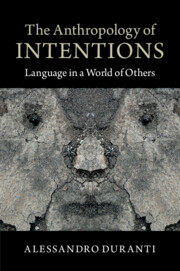Book contents
- Frontmatter
- Contents
- List of figures
- Acknowledgments
- 1 Rethinking anti-intentionalism
- 2 Intentions in speaking and acting: the Standard Theory and its foes
- 3 The avoidance of intentional discourse: a Samoan case study
- 4 The invention of promising in the Samoan translation of the Bible
- 5 Intentionality and truth, revisited
- 6 Speaker intentions and the role of the audience in a political campaign in the US
- 7 A dialogue on intentions
- 8 Opacity of other minds: local theories revisited
- 9 Intentions and their modifications: a lesson from Husserl
- 10 A sense of the other: from intentionality to intersubjectivity
- 11 The intentional continuum
- Appendix A Transcription conventions for English examples
- Appendix B Transcription conventions and abbreviations used in the Samoan examples
- Notes
- References
- Index
10 - A sense of the other: from intentionality to intersubjectivity
Published online by Cambridge University Press: 18 December 2014
- Frontmatter
- Contents
- List of figures
- Acknowledgments
- 1 Rethinking anti-intentionalism
- 2 Intentions in speaking and acting: the Standard Theory and its foes
- 3 The avoidance of intentional discourse: a Samoan case study
- 4 The invention of promising in the Samoan translation of the Bible
- 5 Intentionality and truth, revisited
- 6 Speaker intentions and the role of the audience in a political campaign in the US
- 7 A dialogue on intentions
- 8 Opacity of other minds: local theories revisited
- 9 Intentions and their modifications: a lesson from Husserl
- 10 A sense of the other: from intentionality to intersubjectivity
- 11 The intentional continuum
- Appendix A Transcription conventions for English examples
- Appendix B Transcription conventions and abbreviations used in the Samoan examples
- Notes
- References
- Index
Summary
Introduction
In this chapter, I examine in some detail Searle’s (1990) notion of “collective intentionality” and the distinction he makes between I-Intentions and we-Intentions to argue that, contrary to what is nonchalantly claimed by Searle himself, collective intentionality is not synomymous with and cannot replace the phenomenological notion of intersubjectivity, which is, in turn, a fundamental quality of all kinds of human experiences, including the apparently most individual or private. By reexamining some of Searle’s examples and providing some new ones taken from my own research on jazz instruction and jazz performance, I show that, under closer scrutiny, Searle’s notion of collective intentionality provides a limited and sometimes flawed understanding of how people carry out tasks that involve coordination and collaboration with others, including those tasks that might not seem to qualify as collective. Searle’s realization that the notion of intentionality he presented in his 1983 book needed to be expanded to take into consideration that there is something more than individual actions and individual intentions could be seen as an answer to the anthropological critique of his model (see Chapter 2). But the dichotomy he proposes between individual and collective intentions turns out to be both theoretically and empirically problematic. In the final part of this chapter I suggest that an alternative and better model of both individual and collective action can be built by integrating a phenomenological understanding of intersubjectivity with the empirical study of how people learn to and eventually succeed at coordinating their actions in complex joint activities such as playing in a jazz band.
The theoretical perspective I am favoring in this chapter is built on the assumption that the world of the individual is always a social world. We anticipate the actions of others and need to coordinate with them on a regular basis whether or not we are engaged in activities that are culturally recognized as “collective” or “joint.” Conversely, even those situations that require a high level of coordination and can qualify as collective in Searle’s sense of the term, e.g., playing in a band, require individuals to alternate between attending to their own actions and those of others in situation- and culture-specific ways that can result in smooth interaction.
- Type
- Chapter
- Information
- The Anthropology of IntentionsLanguage in a World of Others, pp. 209 - 232Publisher: Cambridge University PressPrint publication year: 2015

